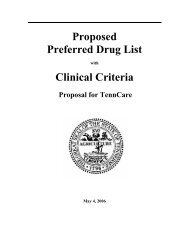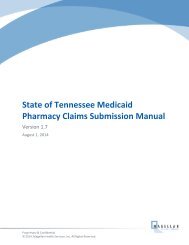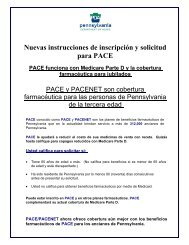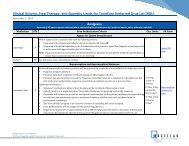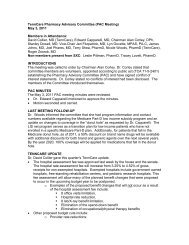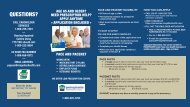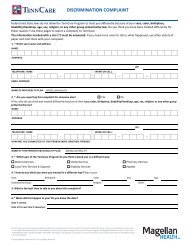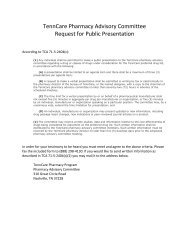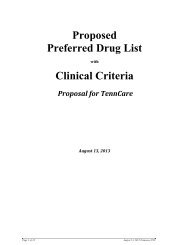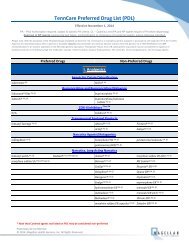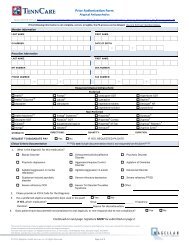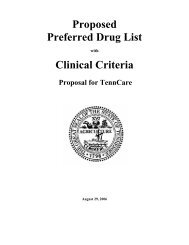TennCare Drug Utilization Review (DUR) Board Minutes - Magellan ...
TennCare Drug Utilization Review (DUR) Board Minutes - Magellan ...
TennCare Drug Utilization Review (DUR) Board Minutes - Magellan ...
- No tags were found...
You also want an ePaper? Increase the reach of your titles
YUMPU automatically turns print PDFs into web optimized ePapers that Google loves.
March 6, 2012<br />
State of Tennessee<br />
Department of Finance and Administration<br />
Bureau of <strong>TennCare</strong><br />
310 Great Circle Road<br />
Nashville, TN 37228<br />
<strong>TennCare</strong> <strong>Drug</strong> <strong>Utilization</strong> <strong>Review</strong> (<strong>DUR</strong>) <strong>Board</strong> <strong>Minutes</strong><br />
In attendance:<br />
<strong>DUR</strong> Committee: Roland Gray, MD, Randall Ellis, MD, Alexander Koumtchev, MD,<br />
Rebecca Brewer Mills, PharmD<br />
Bureau of <strong>TennCare</strong>: David Collier, MD, Ray McIntire, DPh, Nicole Woods, PharmD<br />
SXC Health Solutions: Toie Alston, PharmD, Bill Hudson, PharmD<br />
Introduction:<br />
The meeting was called to order by Dr. Alston, who welcomed everyone to the <strong>TennCare</strong><br />
<strong>Drug</strong> <strong>Utilization</strong> <strong>Review</strong> (<strong>DUR</strong>) <strong>Board</strong> meeting. <strong>DUR</strong> <strong>Board</strong> Appointees, Bureau of<br />
<strong>TennCare</strong> Representatives, and SXC Health Solutions, Inc. Representatives introduced<br />
themselves.<br />
<strong>Review</strong> of minutes:<br />
• The <strong>Board</strong> was asked to review minutes from December 6, 2011 meeting.<br />
• A motion was made by Dr. Collier, seconded by Dr. Gray to approve the minutes<br />
as presented. <strong>Minutes</strong> approved with no changes.<br />
Dr. Collier gave the following <strong>TennCare</strong> Medical update:<br />
• FY 2013 <strong>TennCare</strong> Budget: The governor presented his proposal to the<br />
legislature which included modification to the proposal presented by <strong>TennCare</strong>.<br />
These modifications were for the better.<br />
o Provider rate reduction was amended by the governor. Legislation was<br />
submitted to restore 1.75% of the rate reduction that went into effective in<br />
January 1, 2012. That rate will be retroactive from January 1, 2012. Once<br />
that legislation passes, it will cause rate reduction for FY 12 to be reduced<br />
from 9.5% to 7.75%. Providers affected include nursing homes, ICFs/MR<br />
(Intermediate care facilities for persons with mental retardation), MCO<br />
administrative rates, Transportation providers (NEMT $2 co-pay removed),<br />
and lab/ x-ray providers. Next year the rate will be refunded at that level<br />
with recurring funds.<br />
o<br />
o<br />
o<br />
The governor restored the Perinatal grant (Regional Perinatal Centers).<br />
<strong>TennCare</strong> proposed OB reimbursement at a flat rate of vaginal delivery<br />
+5%. The governor recommended vaginal rate +17% and for next year,<br />
FY 2013, vaginal delivery + 10% with recurring funds. These rates are<br />
greater than what <strong>TennCare</strong> proposed.<br />
The governor approved Emergency Dept physician reimbursement for<br />
nonemergency visits at contract rate or $50, whichever is less, instead of<br />
1
o<br />
o<br />
o<br />
o<br />
the level 1 (approximately $27) reimbursement <strong>TennCare</strong> proposed. Next<br />
year reimbursement will be between $27 and $50 using non-recurring<br />
funds. In FY 2014 the reimbursement rate will be re-evaluated.<br />
Supplemental grants to the Med/ Metro/ Jellico were restored.<br />
TNAAP contract was restored for FY2013 with $100,000 nonrecurring<br />
funds.<br />
Proposed reductions not in the Governor’s budget that will not be<br />
implemented include:<br />
• Eliminate hospice support services for adults<br />
• 1.25% provider rate reduction<br />
• Eliminate adult allergy medication coverage<br />
• Mental health provider rate reduction<br />
• Co-pay for non-pregnant adults for some services<br />
Other changes that are forms of reductions<br />
• Currently <strong>TennCare</strong> has low requirements to be eligible for long<br />
term care requiring only 1 Activities of Daily Living (ADL)<br />
deficiency. This is more generous than most states in the country.<br />
• Tennessee is proposing to change that to 3 groups. The change<br />
requirements for nursing facility care include:<br />
• Deficiencies in 3-4 ADLs to qualify for nursing home<br />
‣ Choices Group 1 - Nursing Home Care Recipients<br />
‣ Choices Group 2 – Home care recipients (HCBS)<br />
Adults 65 years of age and older<br />
OR adults 21 years of age and older who<br />
have physical disabilities<br />
‣ New Group: Choices Group 3<br />
Deficiency in 1-3 ADLs<br />
Not eligible for residential care but will<br />
be eligible for HCBS program<br />
• This will allow <strong>TennCare</strong> to provide services to those in<br />
need without being too liberal regarding nursing home<br />
services.<br />
• HBCS providers are going to see some reduction in their<br />
rates. It’s a blended rate of homemaker and personal<br />
assistant.<br />
• Limit Retroactive Eligibility payments to MCO: Currently if a<br />
member is approved for retroactive eligibility <strong>TennCare</strong> will pay 2<br />
years full capitation rate to the MCO. It’s proposed that <strong>TennCare</strong><br />
pay the full capitation rate for no more than 12 months of<br />
retroactive eligibility and pay only for claims received for services<br />
rendered prior to the 12 months.<br />
• <strong>TennCare</strong> is going to follow CMS policy to not pay for hospital<br />
acquired conditions that could be preventable.<br />
• <strong>TennCare</strong> Standard Spend Down<br />
o The new enrollment opened February 21, 2012.<br />
o There were approximately 2,500 calls in just over an hour.<br />
• EHR Provider Incentive Program<br />
o As of February 17, 2012, $37,242,756.58 has been paid out to 1,011<br />
eligible professionals and 19 eligible hospitals.<br />
• John B Lawsuit<br />
2
o<br />
John B lawsuit addresses the adequacy of EPSDT services provided by<br />
<strong>TennCare</strong> for children under the age of 21. On 2/14/2012, Judge Wiseman<br />
issued a ruling stating that the State is in substantial compliance with all<br />
the binding provisions of the consent decree. He vacated the consent<br />
decree, dissolved all injunctive relief and dismissed the case. The plaintiffs<br />
have said they intend to appeal to the 6 th circuit court.<br />
• ICD -10 Implementation<br />
o<br />
ICD – 10 was scheduled for October 1, 2013. However, CMS has<br />
indicated it’s considering a delay due to concerns from the AMA<br />
(American Medical Association) regarding the burden on physicians to<br />
meet the deadline. There is no information on whether the delay will be<br />
granted at this time. Until further notice, <strong>TennCare</strong> continues to work<br />
toward the deadline requirements for the ICD- 10 implementation that was<br />
previously set.<br />
Dr. Woods gave an update on the <strong>TennCare</strong> Pharmacy Program:<br />
• New NCPDP D.0 Claim Standard format<br />
o<br />
o<br />
o<br />
January 1 st , 2012 the new NCPDP D.0 format went into effect replacing the<br />
previously accepted 5.1 claim format. The transition to the new format<br />
went smoothly.<br />
Pharmacies were allowed a transition period during the month of<br />
December in which both the 5.1 and D.0 formats were accepted, so<br />
pharmacies could properly convert to the new format. During that time<br />
they were encouraged pharmacies to contact SXC to work out any<br />
problems. Pharmacies that wanted to test submission of claims in the new<br />
format were advised to contact SXC to arrange a testing time.<br />
There will be future guidance going out to the pharmacies regarding a<br />
couple new fields required to properly identify 340B claims. The federal<br />
government has put forth some guidance stating that states must have a<br />
way of documenting methodology, how 340B claims are identified and<br />
ensure providers that are identified as 340B providers are submitting their<br />
claims with 340B pricing. Any provider who qualifies as a 340B provider<br />
gets the discount up front so those claims are not eligible for federal<br />
rebates. There will be some future guidance going out as to specifically<br />
what fields will be required and what values need to be put in those fields<br />
to properly identify 340B claims.<br />
• Pharmacy Budget Reductions<br />
o<br />
In FY2013 the proposed budget item regarding implementing a more<br />
aggressive MAC (maximum allowable cost) on certain generic drugs was<br />
postponed due to non-recurring funds. If no additional funds are available<br />
this will go in after FY 2013.<br />
• Proposed Budget Reductions for FY 2013<br />
o<br />
Enhanced Third Party Liability (TPL) - In July 2011, a POS (point of sale)<br />
coordination of benefits (COB) edit was implemented. This COB edit<br />
identified members who were known to have primary insurance and<br />
required that the pharmacy submit the claim to the primary insurance first,<br />
with <strong>TennCare</strong> being the payor of last resort. It’s anticipated that this edit<br />
will continue into the next budget year and will continue to provide savings<br />
for the State. This is a great edit to make sure we are the payor of last<br />
resort.<br />
3
o The Enhanced Specialty Pharmacy Contract Strategy didn’t make it into<br />
the governor’s final proposal.<br />
o The elimination of prescription allergy medication for adults was also<br />
proposed but didn’t make it into the final proposal.<br />
• Suboxone®/ Subutex® Tapering<br />
o Last year a quantity limit on buprenorphine products was proposed which<br />
would allow up to 16 mg/day for up to 6 months. Following this 6 month<br />
time period, the member would need to be tapered down to a quantity limit<br />
of 8mg/day. This quantity limit was implement Sept 1, 2011 so the first 6<br />
month period came up March 1, 2012.<br />
o To assist providers with this taper, multiple provider notices were faxed to<br />
targeted prescribers informing them of the new quantity limit including a<br />
list of patients receiving greater than 8mg/day. Providers were encouraged<br />
to taper their patients down to the new quantity limit. All Suboxone®<br />
providers have been informed of their patients that need to be tapered down<br />
to 8mg/day.<br />
o The average daily dose has decreased from 20mg/day to approximately<br />
13mg/day.<br />
o Dr. Mills asked if the State is able to see if any of these patients are paying<br />
cash.<br />
o Dr. Woods stated there are some patients paying cash. There is nothing<br />
prohibiting them from paying cash however as a Medicaid patient a<br />
physician can’t require them to do so. The downward trend is just a<br />
reflection of <strong>TennCare</strong> claims it doesn’t include claims from controlled<br />
substance database.<br />
o Dr. McIntire mentioned there’s a fraud investigation line at DHS that<br />
pharmacist can call 800-241-2629. Some Medicaid enrollees are eligible<br />
due to a lack of financial ability to pay for expensive medication. If<br />
enrollees are paying cash they may have undeclared income.<br />
• Lastly, the Pharmacy Program will experience a change in leadership effective<br />
March 14, 2012. Dr. Woods informed the <strong>DUR</strong> <strong>Board</strong> that she would be leaving<br />
<strong>TennCare</strong> to explore a new job opportunity and thanked the committee for their<br />
hard work. She stated that at this time a new Pharmacy Director has yet to be<br />
named. However, interviews are currently being conducted and she expressed<br />
confidence that a highly capable person will be selected to fill the position.<br />
Dr. McIntire presented A<strong>DUR</strong>S update:<br />
Every year in February all the states Medicaid <strong>DUR</strong> directors meet in Scottsdale, AZ.<br />
Some of the topics presented are very relevant to what we are discussing. Those programs<br />
have included Dr. Ted Parran’s presentation on Suboxone® two years ago which basically<br />
started our Suboxone® initiative. This year he discussed the new tamper resistant opioids.<br />
Also highlighted, was Montana’s new pharmacy case management program, Arkansas’s<br />
presentation on products we probably aren’t supposed to cover because they’re not drugs,<br />
and important updates from CMS and state <strong>DUR</strong> initiatives.<br />
• Newer “Less Abusable” Opioids<br />
o Dr. Parran presentation centered on dopamine surge in the brain. Basically<br />
all the euphoria producing drugs work differently with different effects but<br />
all cause dopamine surge in the brain. His point for the presentation was<br />
there are a lot of new products coming out to prevent drug abuse but don’t<br />
prevent drug abuse because they don’t stop the dopamine surge. A drug<br />
4
that will stop the dopamine surge is what’s needed out in the industry. The<br />
more the dopamine surge the higher the street value. Dopamine surge<br />
mediates addictive disease and affects the street value of the drug.<br />
• Combination of opiates and benzos- There are more accidental<br />
deaths in patients with sleep apnea than without sleep apnea. We<br />
should consider a <strong>DUR</strong> activity around patients with sleep apnea.<br />
• There are only 2 ways to give an opiate to an addict needing pain<br />
treatment, Suboxone® or Methadone. <strong>TennCare</strong> doesn’t cover<br />
Suboxone® for pain therefore if an addict needs pain treatment<br />
there’s nothing <strong>TennCare</strong> should be giving them for pain<br />
treatment.<br />
• Montana’s New Pharmacy Case Management Program: This is a different way<br />
of running their <strong>DUR</strong> program<br />
o They involve face to face meetings with providers and pharmacists. They<br />
actually pay providers for their office time.<br />
o Letters are sent to providers, and then an appointment is set between<br />
providers and a clinical pharmacist to discuss letter content.<br />
o Scheduled office time is reimbursed by Medicaid using CPT code which<br />
pays $33.04.<br />
o With this program they did Suboxone® academic detailing which provided<br />
best practice guidelines and appropriate medication management. They<br />
saw a shift in claims from 24-32mg /day dose to 8-16mg/day. They didn’t<br />
present outcomes data.<br />
o There is expense to this program, including the cost of 2 full time<br />
pharmacists plus provider charges.<br />
• Medicaid Dilemma- Is it a drug<br />
o<br />
o<br />
There are a number of products that look like drugs, are marketed like<br />
drugs, require a prescription, and have a NDC number but they are not<br />
drugs- they are devices. For Medicaid to cover these products they have to<br />
be drugs.<br />
The manufacturers are a “Covered Labeler” according to CMS and are<br />
rebate eligible but rebates are not available for these products because they<br />
are not drugs. “Cover Labeler” may not have a rebate agreement on file<br />
with CMS for that NDC. All manufacturers must have rebate agreements<br />
with CMS and the State to be able to have the drugs covered by state<br />
Medicaid programs. Basically Arkansas went through a process to help<br />
define whether these drugs are devices or medical foods:<br />
• Examples include: Deplin® and other l-methylfolate products.<br />
<strong>TennCare</strong> does cover these products in certain patients as a less<br />
costly alternative to other treatments.<br />
• Other products include, Freshkote® Eye Drops which is an eye<br />
lubricant that’s not FDA approved.<br />
• Hyaluronate sodium is a non-FDA approved product which<br />
requires a prescription but it’s not a drug.<br />
• Urea is another product which can be covered in combination with<br />
products such as hydrocortisone cream; however urea by itself is<br />
an emollient, and is not a drug.<br />
• Medicaid can cover non-drug under home health, or medical or<br />
thru pharmacy as a less costly alternative.<br />
• CMS General Updates<br />
5
o<br />
o<br />
o<br />
o<br />
The General Accountability Office conducted a study on atypical use in<br />
foster children which revealed that foster children comprise approximately<br />
3% of children enrolled in Medicaid, but they are prescribed atypical<br />
antipsychotics at 9 times the rate of non-foster children. A letter was sent<br />
to state Medicaid directors in November challenging the states to take<br />
action. In the letter it was pointed out that states may use <strong>DUR</strong> programs<br />
to monitor dispensing at the point of service and influence prescriber<br />
behavior. <strong>DUR</strong> programs may use system edits to limit inappropriate<br />
dosage utilization and poly-pharmacy. States can also use their Retro<strong>DUR</strong><br />
programs to reach out to providers whose prescribing habits vary<br />
significantly from the recommended standard of care for children. A while<br />
back, <strong>TennCare</strong> worked on utilization of atypicals in children and foster<br />
children.<br />
Dr. McIntire asked if anyone remember the outcomes.<br />
Dr. Collier stated that atypical use in children was reviewed for DHS.<br />
Tennessee data was compared to 14 other states and was in the middle.<br />
Dr. Woods mentioned that <strong>TennCare</strong> sent out educational material to<br />
providers which included some guidance that came from one of the<br />
journals regarding safety and efficacy in children and algorithms to use as<br />
they work through diagnosis in children. The drill down on kids receiving<br />
high doses showed they had tried and failed a variety of things in the past<br />
and they were some of the most difficult cases. These patients were being<br />
appropriately monitored by psychiatrists and not general practitioners.<br />
Overall it was felt that the utilization was appropriate.<br />
• Individual State Updates: Here are some interesting things other states are doing.<br />
Tennessee is really out front when it comes to our clinical criteria and edits. Some<br />
states can’t management certain categories and some don’t have a PDL. Alabama<br />
and Missouri may be a little more advance in some program aspects.<br />
o<br />
o<br />
o<br />
o<br />
o<br />
o<br />
Alabama has a new atypical PA program. Children’s PAs are approved<br />
only if written by a child psychiatrist. For adults, atypical PA requests<br />
must be written by psychiatrist, otherwise, if written by provider other than<br />
a psychiatrist a diagnosis is required.<br />
Arizona implemented new pricing rules for 340B providers, reimbursing<br />
the lower AAC or the 340B ceiling price.<br />
Delaware implemented a new adult ADHD coverage. They will only<br />
approve long acting simulants for adults. On 3/1/12, new opiate guidelines<br />
went into effect which include:<br />
• oxycodone IR 30mg max quantity of 60 tablets per year<br />
• oxycodone IR 15mg max quantity of 240 tablets per year.<br />
• All further claims require prior authorization, and require use of a<br />
long acting opiate (LAO) before oxy IR 15mg or 30mg will be<br />
approved. Total daily oxy IR dose will only be approved to equal<br />
not greater than 20% of the total daily LAO dose<br />
Iowa changed their reimbursement formula to AAC plus an increased<br />
dispensing fee. Only one dispensing fee will be paid per month for<br />
maintenance drugs.<br />
Maine instituted a 2 year limit on Suboxone®, and a 45-day limit on<br />
narcotic use, excluding HIV and cancer patients. A prior authorization is<br />
then required for those patients being treated for chronic pain.<br />
Maryland requires peer reviews to be conducted by U of M School of<br />
Medicine for all prescribed mental health drugs.<br />
6
o Montana implemented a “Provider” PA program. Providers can put a stop<br />
on drugs that they have prescribed.<br />
o North Dakota required a PA for all opioid combinations containing greater<br />
than 325mg of APAP.<br />
o Oklahoma stopped paying for prescriptions for all non-participating<br />
providers. Notices were sent only to enrollees, not the providers.<br />
o In April 2012, Oregon will be implementing a quantity limit of 120mg/day<br />
MS equivalent of all opioids, with the exception of cancer patients. A<br />
urine drug screen will be required for prior authorization.<br />
o Virginia implemented an edit on atypicals for children under age 6. All<br />
requests are subject to a peer to peer review with a State psychiatrist.<br />
o Washington requires a second opinion by a pain specialist for narcotic<br />
reviews for doses > 1000mg MS equivalents per day, with the exception of<br />
cancer patients.<br />
o West Virginia requires a prior authorization for atypicals in children under<br />
age 6.<br />
• They also implemented a “Provider Report Card” for narcotic<br />
prescribers. They separate out physicians and mid-levels, and then<br />
compared the mid-levels to their supervising physicians.<br />
o Wisconsin will be implementing an ER Lock-In. They also require a PA<br />
for atypicals in children under age 6, and the prescription must be written<br />
by a child psychiatrist.<br />
Old Business from December 6, 2012 meeting:<br />
• Atypical Antipsychotic <strong>DUR</strong> Activity Letter: The Atypical Antipsychotic<br />
Activity Letter was tabled at last meeting to allow Dr. Koumtchev to give his input<br />
on the letter.<br />
o<br />
o<br />
o<br />
o<br />
o<br />
o<br />
o<br />
Dr. Koumtchev stated he understands the barriers to this letter. As it’s<br />
difficult to describe what’s evidence based and standard practice. He will<br />
draft a letter and send for review.<br />
Dr. Woods mentioned they have received legal guidance on what can and<br />
can’t be voted on via email. The actual letter would have to be voted on at<br />
a meeting however the letter may be distributed via email to receive<br />
feedback and comments.<br />
Dr. McIntire stated it’s very difficult for the State to write this letter<br />
strongly so we are really looking to the <strong>Board</strong> to help set the tone for this<br />
letter.<br />
Dr. Alston informed the <strong>Board</strong> the letter will be brought back in June<br />
for a vote.<br />
Physician Referral Letter: In your packet you have a copy of the<br />
physician referral letter that the State developed for referring blocked nonparticipating<br />
prescribers to the <strong>Board</strong> of Medical Examiners.<br />
Dr. Hudson mentioned that Oklahoma has a process like this but it wasn’t a<br />
peer review process. They have a more statutory process where if you’re<br />
not in the managed care organization then you are an outlier.<br />
Dr. Woods stated the Bureau is having discussions with legal regarding this<br />
process, and down the road our process may look similar to Oklahoma,<br />
where anyone not contracted with the MCOs will not be able to have<br />
prescriptions reimbursed by <strong>TennCare</strong>. Within the Bureau there is<br />
difference in opinion on the guidance that was issued by CMS; therefore<br />
discussion is still taking place.<br />
7
o<br />
A motion was made by Dr. Gray, seconded by Dr. Mills to accept<br />
referral letter without changes. Committee approved.<br />
Standing Business:<br />
• Blocking Non-Participating providers- Dr. McIntire provided the <strong>Board</strong> with a<br />
summary of the reasons why each of the thirteen providers was being reviewed,<br />
and blinded copies of their prescribing histories.<br />
o Dr. McIntire presented prescriber #1: This prescriber is an APRN with<br />
approximately 78% of total paid claims for controlled substances and 68%<br />
of total paid claims for oxycodone products. An article from a Tennessee<br />
newspaper about the prescriber and the prescriber’s pain clinic practice was<br />
also presented. There are no prior authorizations from this provider and<br />
there is only one <strong>TennCare</strong> enrollee who is subject to the Lock-In program<br />
found with claims from this provider within the last 12 months.<br />
• Dr. Gray mentioned there are rules and regulations for pain clinics.<br />
Prescribers doing this kind of business have to be registered. You<br />
should be able to go on line and see if they are registered. If they<br />
are not registered both the clinic and physician can be fined. Also<br />
with the new pain clinic regulations the <strong>Board</strong> has a right to go and<br />
investigate without a complaint.<br />
• A motion was made by Dr. Gray, seconded by Dr. Mills to<br />
block prescriber number #1.<br />
o Prescribers #3-5 and 7-13: These are all out of state Suboxone®<br />
prescribers. Most of these prescribers are in cash Suboxone® clinics over<br />
150 miles from Tennessee border. The Medicaid pharmacy director in that<br />
state gave me the name of a P&T member who was a pharmacy owner in<br />
the city from where we were seeing the most claims. The pharmacist told<br />
me that he will not fill prescriptions from this clinic, and the owner hires<br />
residents and retired practitioners to see patients. There are 7 different<br />
locations throughout the state with the same name for counseling at each<br />
location. We are still awaiting MCO approval on blocking these providers.<br />
• Dr. Koumtchev mentioned DEA has been visiting everyone with X<br />
DEA number. The website registration is confusing; the addressee<br />
requested isn’t specific to home or office.<br />
• Dr. Collier indicated this company has an office in Tennessee.<br />
• Dr. Koumtchev stated there are many providers with X DEA<br />
number. The V.A asked all physicians that participate in rounds to<br />
have an X DEA.<br />
• Dr. Gray asked if these physicians are licensed in state of<br />
Tennessee.<br />
• Dr. McIntire responded that 1 of the providers was registered in<br />
Tennessee.<br />
• Dr. Woods asked if the patients are counting toward these<br />
prescribers’ 100 patient limit, and if patients are being seen in the<br />
Tennessee clinic.<br />
• Dr. McIntire stated there is no reason for enrollees to drive 150<br />
miles into another state to see an out-of-state physician for<br />
addiction treatment.<br />
• Dr. Woods asked if there are different prescribers in the out-ofstate<br />
clinics that are not practicing in Tennessee.<br />
8
• Dr. McIntire informed these are not the same providers.<br />
• Dr. Woods stated that it’s agreed that traveling 150 miles to a<br />
Suboxone® clinic is not what we want patients to do so we decided<br />
to block these providers, and the MCOs must have alternative<br />
providers to treat these enrollees.<br />
• Dr. McIntire stated if the MCOs come back and say these<br />
providers are needed they will not be blocked. This action is<br />
contingent on the MCOs saying they don’t need these providers.<br />
• Dr. Alston stated since they are not getting the prescription filled in<br />
Kentucky, maybe they are not actually going to the Kentucky<br />
clinic.<br />
• Dr. McIntire mentioned there is one city in Kentucky that’s the hot<br />
spot for this.<br />
• A motion was made by Dr. Gray, seconded by Dr. Koumtchev<br />
to block provider 3-5 and 7-13 subject to approval by the<br />
MCOs.<br />
o Dr. McIntire asked that provider #2 be postponed and provider 6 be<br />
dismissed.<br />
o Prescriber #14: A <strong>TennCare</strong> enrollee locked into a pharmacy in Kingsport<br />
could not get his prescription filled as the pharmacist will not fill<br />
prescriptions from this provider. The pharmacist believes this is a newly<br />
opened pain clinic that doesn’t accept insurance and the prescriber<br />
commutes from out of state. This provider is not prescribing narcotic pain<br />
relievers according to current standard of care. The enrollees’ utilization<br />
has been reviewed for February along with PMP claims from the<br />
prescriber’s PMPM profile and cash purchases. Cash purchases for this<br />
provider are alarming.<br />
• A motion was made by Dr. Gray, seconded by Dr. Ellis to<br />
block provider #14.<br />
• Dr. Gary recommended carbon copy to DEA<br />
• Dr. McIntire reminded the board the approval to block will be<br />
contingent upon MCO approval.<br />
• Committee approved motion with additions.<br />
• Dr. Alston Presented <strong>TennCare</strong> <strong>Drug</strong> <strong>Utilization</strong> Data<br />
o <strong>TennCare</strong> population remains constant at approximately 1.2 million<br />
enrollees. In regards to utilization, the number of utilizing members as<br />
well as the prescription count decreased slightly from 4q10 to 4q11;<br />
however during the same time frame the overall payment amount increased<br />
11% and the average payment per claim increased 11.55%. Between 1-2%<br />
of the increase can be attributed to the new protease inhibitor drugs used to<br />
treat Hepatitis C (Incivek®, Victrelis®), and the rest is due to increases in<br />
various drug classes, especially those listed in the Top 10 Therapeutic<br />
Classes by Payment Amount.<br />
o Looking at the average prescription payment, overall generic utilization<br />
continues to increase keeping payment amount down.<br />
o The brand originator category shows a significant increase in payment<br />
amount. This is due to release of generic olanzapine. For a short time,<br />
brand Zyprexa® claims were paying however they had not yet been added<br />
to the Brand as Generic list. Therefore, they processed as a brand<br />
originator verses a generic. The high cost of Zyprexa® claims affected the<br />
brand originator category much more than the generic category, as the<br />
9
generic category comprises 84% of <strong>TennCare</strong> pharmacy claims verses the<br />
brand originator at only 0.34%.<br />
o There are 5 classes of drugs in both the top 10 claim volume and top 10<br />
payment amount. Those drugs classes consist of Narcotic Analgesics,<br />
Anticonvulsants, ADHD Agents, Sympathomimetics, and Atypical<br />
Antipsychotics.<br />
o Generic olanzapine (Zyprexa®) became available in Oct 2011. Generic<br />
quetiapine (Seroquel®) will be available in March. Perhaps in the next year<br />
and half we will see a decline in atypical antipsychotic payment amount.<br />
o Antihemophilic agents’ payment amount increased 38% due to increased<br />
utilization. There have been 5 additional hemophilic enrollees since 4q10.<br />
There has been an increase in the utilization of NovoSeven®.<br />
o Simvastatin claims decreased approximately 10%. This is primarily due to<br />
the recommendation from the FDA to limit the use of simvastatin 80mg. A<br />
<strong>DUR</strong> activity went out in June 2011 to notify prescribers of the FDA<br />
recommendation which included dosage restrictions, a limitation on the use<br />
of the 80mg dose, and the addition of new contraindications to<br />
simvastatin’s label.<br />
o Synagis® payment amount increased 20% PMPM. This increase is<br />
secondary to increased utilization this RSV season.<br />
o The top ranking Pro<strong>DUR</strong> edits in various categories are similar to their<br />
ranking in 4q10. One exception is that the drug causing the highest<br />
number of “Geriatric Precaution” alerts was amlodipine besylate, with<br />
2,579 edits. Geriatric patients are more likely to experience a delayed<br />
clearance of amlodipine and can be at greater risk for toxicity. This could<br />
possibly be a good topic for a <strong>DUR</strong> activity.<br />
• Dr. Alston presented 4 th Quarter Retro<strong>DUR</strong> and Provider Analysis Activities<br />
o Strattera® Cardiovascular Safety--The October activity focused on safety<br />
concerns surrounding use of atomoxetine (Strattera®), specifically<br />
regarding the potential increase in blood pressure and heart rate. 569<br />
profiles were reviewed, and 89 letters addressing 86 enrollees were sent to<br />
prescribers, when the enrollee’s profile contained a paid prescription<br />
claim(s) for atomoxetine and a cardiovascular medication.<br />
o Antiretroviral Non-compliance-- The December activity concentrated on<br />
non-compliance with antiretroviral therapy, and 504 enrollee profiles were<br />
reviewed. A letter to the prescriber was generated when the enrollee did<br />
not obtain a refill of their antiretroviral medication within 7 days after the<br />
medication supply was expected to run out. We tried to avoid sending the<br />
letter in situations where it appeared the enrollee was ill or hospitalized or<br />
situations where there had been change in therapy. Twenty six providers<br />
were lettered addressing 43 patients.<br />
o Top Narcotic Prescribers-- Out of the top 200 narcotic prescribers the top<br />
125 was lettered.<br />
o Short Acting Narcotic Initiative-- A total of 1,636 prescribers were found<br />
to meet the criteria during the Short Acting Narcotic initiative analysis,<br />
from that total, 800 prescribers were lettered.<br />
o Smoking Cessation-- A communication about smoking cessation was<br />
requested by PAC (Pharmacy Advisory Committee) and the resulting<br />
notice provided additional information on the quantity limits and<br />
10
exceptions under which smoking cessation products would be covered for<br />
all <strong>TennCare</strong> enrollees. This communication was sent to 764 prescribers.<br />
o Buprenorphine Benefit Limit-- A letter was sent to remind providers that<br />
beginning March 1, 2012; any adult <strong>TennCare</strong> recipient who has received 6<br />
months of therapy on Suboxone®, Subutex®, or generic buprenorphine<br />
will be limited to a maximum daily dose of 8 mg/day. There were 13,936<br />
providers with patients receiving greater than 8mg per day. These<br />
prescribers are being lettered based on the date the patient will reach 6<br />
month mark. 194 letters went out to providers whose patients will reach 6<br />
months of therapy sometime in March. The next round will be sent out this<br />
week to physicians with patients will reach the 6 month mark in April.<br />
• Dr. Alston presented Retro<strong>DUR</strong> and Provider Analysis Activity Outcomes<br />
o ADHD Stimulants with CNS Depressants-- This activity’s focus was to<br />
draw attention to counteractive prescribing with <strong>TennCare</strong> enrollees taking<br />
ADHD products concomitantly with CNS depressants. There was a 19%<br />
provider response rate, and 77.9% of the responders found the activity<br />
useful. 38.98% of the responders stated that the patients had diagnoses<br />
which required both medications (CNS stimulants and depressants).<br />
o Use of Topamax® During Pregnancy-- This activity reviewed the risk of<br />
orofacial birth defects in children born to mothers taking topiramate<br />
(Topamax®). 13.9% of the prescribers who received the letter responded,<br />
69.8% found this activity useful.<br />
o Simvastatin Dose Restriction-- This activity reviewed the action that the<br />
FDA took on simvastatin, which included dosage restrictions, limitation on<br />
the use of the 80mg dose, and the addition of new contraindications to<br />
simvastatin’s label. 10.5% of the prescribers who received the letter<br />
responded, 76.3% found the activity useful. 30% of the responders<br />
planned to adjust treatment based on the information we provided.<br />
o Poly-Pharmacy-- Activity focused on patients with > = 14 prescriptions,<br />
written by > = 4 different providers, and filled at > = 3 different<br />
pharmacies over a 90 day period. 14.4% of the providers responded, of<br />
which 75.8% thought the activity was useful.<br />
o Strattera Adverse Reaction-- The Strattera® activity focused on safety<br />
concerns surrounding the use of Strattera® particularly the increase in<br />
blood pressure and heart rate. There was a 19.7% provider response rate,<br />
and 64.7% of the responders found the activity useful.<br />
o Top Narcotic Prescribers-- Top Narcotic Prescribers had 27.4% response<br />
rate of that 64.7% thought this activity was useful. Most of these responses<br />
are generally negative. Pain clinics states it’s their job to write pain<br />
medication. Suboxone® prescribers don’t understand why they are included<br />
since they are running a rehabilitation clinic and not prescribing medication<br />
for pain.<br />
• Dr. Woods recommended breaking the specialty down further to<br />
include a Suboxone® category.<br />
• Dr. Gary recommended including a copy of the letter from Center<br />
of Substance Research to educate the prescribers that this<br />
medication can be abused.<br />
o Smoking Cessation in Pregnancy-- Smoking cessation in pregnancy, this<br />
activity reviewed <strong>TennCare</strong> criteria for coverage of smoking cessation<br />
products for pregnant women prior to these agents becoming a covered<br />
11
enefit for everyone. There was a 6.0% provider response rate of that<br />
79.4% thought the activity was useful.<br />
o Short Acting Narcotic Initiative-- There was a 17.3% provider response<br />
rate, and 74.2% of the responders found the activity useful. From 3Q09 to<br />
4Q11 there’s been a 10% decrease in number of narcotic claims per<br />
utilizing member. Since this activity is now going out quarterly there’s<br />
been some discussion regarding modifying the letter to be more aggressive.<br />
• Dr. McIntire informed the board that the subcommittee on narcotic<br />
use will be reconvening in the upcoming months to focus on trends<br />
we are seeing today and specifically oxycodone IR 30mg.<br />
o Promethazine Safety in Children-- Promethazine safety in children<br />
reviewed the “black box” warning added to promethazine’s label in 2004<br />
involving contraindications for use in children less than 2 years of age and<br />
advising against the use of promethazine with codeine cough syrups in<br />
children less than 6 years of age. This activity had a 12.6% provider<br />
response rate and of that 66.1% found this activity useful.<br />
o Buprenorphine Benefit Limit-- This provider analysis activity focused on<br />
Suboxone® new quantity limits that went into effect last quarter. There<br />
was a 19.7% response rate and of that 67.6% found this activity useful.<br />
Approximately 35% of the responders was aware of the quantity limit<br />
changes and had already adjusted patients’ therapy where appropriate.<br />
o Smoking Cessation-- The general smoking cessation letter addressed the<br />
quantity limits and criteria under which these products would be covered<br />
for <strong>TennCare</strong> recipients. There was a 4.0% provider response rate of that<br />
88.8% found this activity useful.<br />
• Dr. Alston proposed new Retro<strong>DUR</strong> and Provider Analysis Activities<br />
o Non-compliance with Immunosuppressants Agents-- Noncompliance with<br />
antirejection medications is the leading cause of acute rejection.<br />
o Statin Use in Females of Child Bearing Age-- During another review it was<br />
noticed that there were a number of females of child-bearing age receiving<br />
statins and no methods of contraception.<br />
o Statin Medication and Increased Risk for Diabetes Mellitus-- This activity<br />
will review the article published by Archives of Internal Medicine, which<br />
concluded that statin medication use in postmenopausal women is<br />
associated with an increased risk for DM.<br />
o Topical Antifungal verse fluconazole-- This activity will inform providers<br />
that it’s cheaper to use oral fluconazole than a topical antifungal such as<br />
miconazole.<br />
• Dr. McIntire presented Pharmacy Lock In Program:<br />
o The policy has been finalized.<br />
o Targeted pharmacies and targeted physicians have been redefined. A target<br />
physician is now defined as the top 100 non-participating narcotic<br />
providers. Targeted pharmacies have been changed to out of state<br />
pharmacies and those pharmacies with known violations.<br />
o Suboxone® users are getting locked in as they come. Currently the 4,000<br />
user have not been locked-in. This is a very manual process; some changes<br />
may have to be made. In fourth quarter there was 151 re-reviews.<br />
o We had a 100 pharmacy lock-in change request. 59 requests were granted<br />
approval. There are times after reviewing an enrollee lock-in change<br />
request it’s determine that the enrollee needs to go to re-review.<br />
12
o<br />
o<br />
o<br />
o<br />
o<br />
o<br />
o<br />
o<br />
There will be a letter sent to the lock-in pharmacy notifying the pharmacy<br />
that the patient is locked-in, why the patient is locked-in, and some<br />
common things to do and what not to do. The letter also communicates<br />
how to get the person unlocked.<br />
Another letter will go to the pharmacy that the person was using that’s not<br />
the lock-in pharmacy. The letter will tell the pharmacies they should no<br />
longer fill <strong>TennCare</strong> prescriptions for this enrollee. Once the non-lock-in<br />
pharmacy is notified and continues to fill <strong>TennCare</strong> covered prescriptions it<br />
will probably become a targeted pharmacy because at that point they know<br />
what is expected.<br />
The policy has provisions for special circumstances such as when a drug is<br />
unavailable.<br />
Dr. Woods mentioned if the request for lock-in change is due to relocation<br />
the enrollee would have to register the new address with DHS.<br />
Dr. Collier asked how would other pharmacists at the non-lock- in<br />
pharmacy, for example a floater, know not to fill prescription for the lockin<br />
patient.<br />
Dr. Mills mentioned without running a claim the only way would be to flag<br />
that patient profile maybe with a note.<br />
Dr. Alston stated there have been legal cases regarding note placing on<br />
patient profiles.<br />
Dr. McIntire reiterated these letters are being sent to ask pharmacists to be<br />
part of the solution.<br />
• Dr. Alston announced the December meeting was moved to November 27<br />
due to schedule conflicts. A new schedule will be sent out to include the<br />
revised September and November meetings dates.<br />
Meeting was adjourned at 11:50pm<br />
Next <strong>DUR</strong> <strong>Board</strong> Meeting scheduled for June 5, 2012<br />
13



